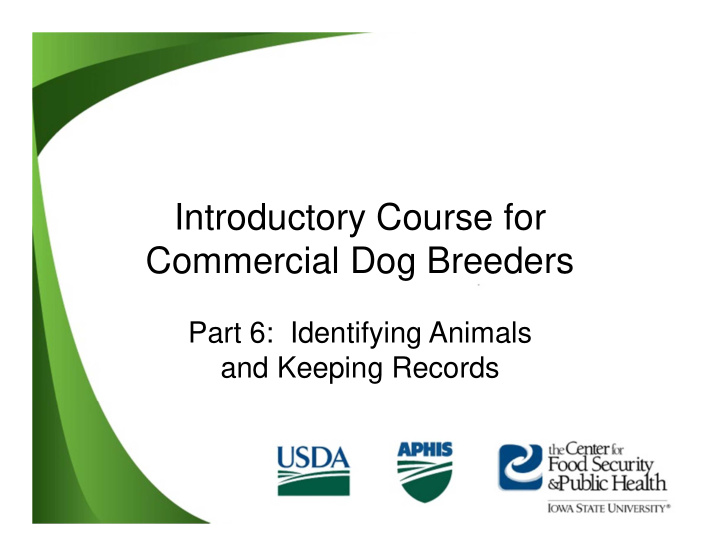



Introductory Course for Commercial Dog Breeders Part 6: Identifying Animals and Keeping Records
Learning Objectives 1. Describe approved methods for identifying dogs 2. Explain how to properly complete APHIS Forms 7005 and 7006 3. Describe what records need to be kept and how long they must be kept
Identification Requirements
Which Dogs Need ID? All adult dogs at facility must have official USDA identification, including: 1. Puppies 16 weeks old or older 2. Dogs temporarily at the facility for breeding 3. Personal pets used for breeding 4. Intact personal pets not used for breeding but housed with breeding dogs 5. Spayed/neutered dogs housed in the kennel
Class A Licensees (Breeders) Adult dogs – 1. Official USDA tag on a collar around dog’s neck; or 2. Legible USDA-approved tattoo; or 3. Microchip – approved by USDA
Class A Licensees (Breeders) Puppies less than 16 weeks old: 1. Official USDA tag; or 2. Distinctive or legible tattoo; or 3. Plastic-type collar with id information written on it; or 4. Cage card with required information
Class A Licensees (Breeders) Unweaned puppies: • Individual identification not needed when with dam and litter in same enclosure.
Class A Licensees (Breeders) Weaned puppies in a litter -- Cage card with: USDA + license no. + dog number
Class B Dealers 1. Official tag on a collar, microchip. or official tattoo 2. Dogs already identified by another dealer/exhibitor: • Existing tag or tattoo or replace with new tag or tattoo • Must record both numbers on records • Microchip 3. Puppies less than 16 weeks: • Official tag, tattoo or plastic collar 4. Unweaned puppies • Individual ID not needed if in litter with dam
Types of Official Identification
Microchips • Implantable chips placed under the skin • Transmit identification number • Need a scanner to read microchip – Different brands need different scanners
Approval Use must be approved by USDA Animal Care Requirements: 1. Placed in standard anatomic location 2. Scanner available on site 3. Records indicate microchip number, location and manufacturer 4. Animals transferred must have alternate identification if new owner not using microchips
Official Tags • Number assigned when license issued • Receive number in mail with license certificate • Licensees order tags • List of some vendors available from USDA
Materials Durable alloy: brass, bronze or steel Durable plastic Aluminum: suitable thickness
Size and Shape
Information
Puppies less than 16 weeks • Plastic-type collar: – Licensee state and identification number – Animal number – USDA • Cage card – Required identification information – Additional information (DOB, dam’s info, vaccinations)
Lost Tags Keep track of all tags in your records If tag is lost: – try to find tag and reapply – If can’t find; • Affix a new tag on the animal • Record the new ID number on Form 7005
Destroyed/Illegible Tags If tag is destroyed or becomes illegible: • Affix a new tag on the dog • Record the new tag number on Form 7005 • Keep old tag – One year after removal, or – Longer than one year if requested by APHIS official
Retention and Reuse Dogs that die or are euthanized – keep tags for 1 year after death – available for inspection – dispose in a manner to prevent reuse Do not reuse numbers for 5 years
Collars Acceptable: – Leather, plastic, some chain NOT ACCEPTABLE: – Wire, elastic, sharp metal
Records
Acquisition and Disposition of Dogs Must record dogs in and out of facility
Variance for Computerized Forms • Forms 7005 and 7006 are required • In some situations, can request a variance – Apply to Regional Office – Give reason why APHIS Forms not suitable – Provide alternative to required forms
APHIS Forms 7005 and 7006 Correctly Completing
APHIS Form 7005
USDA License Number USDA license and registration number: Complete this once you receive a license number.
Identification
Age/Date of Birth Use date of birth, if possible.
Acquisition Information Name, address, USDA license number OR driver’s license number and state, vehicle license number and state If not available, At least 2 of the following: – SSN, phone number, directions to premises, official Id card number
Disposition For animals no longer on premises Box K: indicate “died” or “euthanized”
APHIS Form 7006
APHIS Form 7006
Date of Disposition Date the animals were transferred.
Buyer/Seller License Number
Identification Box 5A: Identify each animal: tag, tattoo, microchip Box 5D: Age or date of birth
Transportation Company Information about company transporting dogs.
Examples
Example 1 Fred Adams: Class A license Breeds and sells pugs, beagles and puggles
APHIS Form 7005
Example 2 Mr. Adams sells 3 puggle puppies to Paul’s Puppies. Completes APHIS Form 7006 to record the transfer
Form 7006
Example 3 Mr. Smith trades a puggle puppy with Ms. Walker, a licensed dealer in Oregon. The puppy will be shipped on American Airlines. Mr. Smith will take the dog to the airport.
Form 7006
Record Retention Requirements
Recordkeeping – Purchased or – Sold or otherwise otherwise acquired disposed of – Owned – Offspring of animals in licensee’s possession – Held or control – In possession or – On premises for control breeding purposes – Transported – Personal pets housed – Euthanized at licensed facility
How Long do I Keep Records? • 1 year after animal euthanized, dies or otherwise disposed of • Longer period if notified by the Administrator
Conclusion You should now be able to explain: • AWA approved methods of identifying dogs • Proper completion of APHIS Forms 7005 and 7006 • Recordkeeping requirements under the AWA
Questions?
Acknowledgments This presentation was prepared by the Center for Food Security and Public Health, Iowa State University through a cooperative agreement with USDA APHIS Animal Care
Recommend
More recommend